Address any questions or comments regarding this newsletter to the individual authors listed after each article or to its editors, Nathan Johanning, 618-939-3434, njohann@illinois.edu or Bronwyn Aly 618-695-6060, baly@illinois.edu. The Illinois Fruit and Vegetable News is available on the web at: http://ipm.illinois.edu/ifvn/. To receive or be removed from email notification of new postings of this newsletter, contact Nathan Johanning or Bronwyn Aly at the phone numbers or email addresses above.
In This Issue:
Upcoming programs (listings for beginning and established growers)
News & Announcements (Welcome Dr. Kacie Athey, University of Illinois Specialty Crops Extension Entomologist, Pumpkin Field Day Virtual & In-Person September 3, ILFMA COVID-19 Mini-Grant and Technical Assistance Opportunity)
Regional Reports (St. Louis metro east, southwestern Illinois (Waterloo), southern Illinois (Murphysboro), Dixon Springs)
Fruit & Vegetable Production & Pest Management (Cucurbit Downy Mildew confirmed in Illinois)
Upcoming programs
See the University of Illinois Extension Local Food Systems and Small Farms Team’s website at:
http://web.extension.illinois.edu/smallfarm/ and the calendar of events at http://web.extension.illinois.edu/units/calendar.cfm?UnitID=629.
- Great Lakes Vegetable Producers Network – Roundtable Discussions. Every Wednesday 12:30 ET/11:30 CT from the first week of May through the first week of September. Great Lakes Vegetable Producer’s Network, a live weekly roundtable discussion during the growing-season for commercial vegetable producers in the Great Lakes and Midwest region. Join us! We broadcast live via Zoom at every Wednesday. Check out the website for the next upcoming topics. If you have a pressing vegetable production issue that you would like discussed, simply email it, along with your phone number, to greatlakesvegwg@gmail.com.
- Pumpkin Field Day. Thursday September 3, 2020 SIU Belleville Research Center, 2036 Charles Ln. Belleville, IL 62221. Limited number in-person tours at 10 a.m. 1 p.m. and 2 p.m.; Virtual tour online at Noon CDT. Variety and Pest Management trials and much more! For more information see the “News & Announcements” in this issues or visit https://extension.illinois.edu/events/2020-09-03-2020-pumpkin-field-day. Contact Nathan Johanning at njohann@illinois.edu or 618-939-3434 for more details.
- Midwest Mechanical Weed Control Field Day. Each virtual session will be streamed online through Facebook Live from 12:30pm to 1:15pm on the following Fridays in September:
September 11 — Episode 1: Drone Wars, an exploration of camera-guided cultivation in row crops
September 18 — Episode 2: The Awakening, a demonstration of tool set-up and in-shop adjustments
September 25 — Episode 3: The First Encounter, precision cultivation in direct-seeded vegetables
To register and find additional information, including an overview of the tools being demonstrated, please visit https://thelandconnection.org/event/mwc-2020/.
News & Announcements
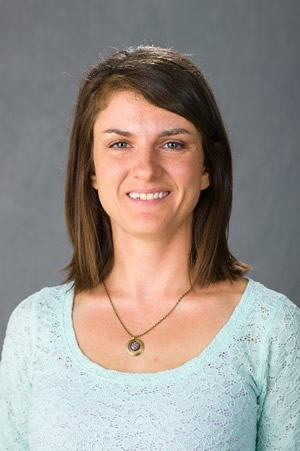
Welcome Dr. Kacie Athey, University of Illinois Specialty Crops Extension Entomologist!
Hi, I am Kacie Athey and I will be starting August 28th as the specialty crops extension entomologist at U of I. I am thrilled to be back in the Midwest again, I grew up in Nebraska and did my undergraduate work at the University of Nebraska at Omaha. I next moved to Kentucky and completed a Masters degree and PhD. My PhD contained a variety of projects, including investigating stink bug control, but perhaps most interesting to specialty crops growers, I worked on insect control in organic squash and melon. I am interested in the practical applications for growers and in our squash and melon experiments, we were testing different kinds of row covers to exclude insects, but also to make the area underneath more hospitable for the plants and even workers who might have to scout for pests and diseases. Our research showed that more breathable row covers resulted in higher yield and fewer pests. In addition, I am interested in the natural predators present in a system. Most of my projects contain a DNA component so I can track the predation of pests by spiders and predatory insects. I plan to continue to combine molecular and applied techniques once I start in my new role.
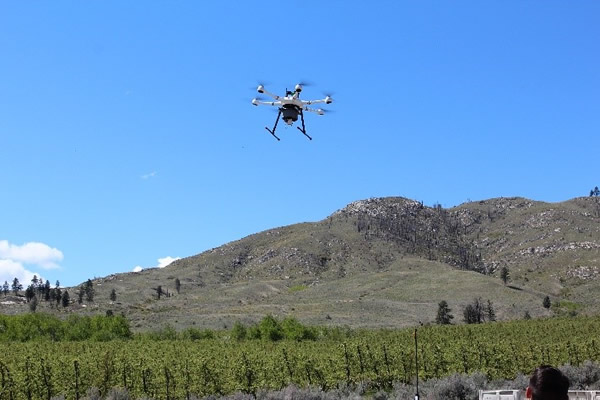
Once I received my PhD, I did a short post doc studying bed bug behavior after exposure to insecticides. It was a fun project and really important research, but I missed being able to work outside, so I moved to Washington state to do a post doc working on apples at Washington State University. There, I worked on a very interesting project on codling moth control. We were using an old technique where we release sterile codling moths into the orchards. The sterile moths then mate with the wild moths and the eggs do not hatch, thus reducing the size of the next generation of pests. We utilized drone technology to deploy the moths allowing us to cover many acres of apples in just a few minutes. We work in organic production and this technique works well because it is extremely specific to codling moth and is not insecticidal. It has been a fascinating project to work on and I hope to continue to study unique methods of insect control in addition to the more traditional chemical insecticides. In addition, I have continued to dabble in stink bug control, which will be very relevant to growers here as well.
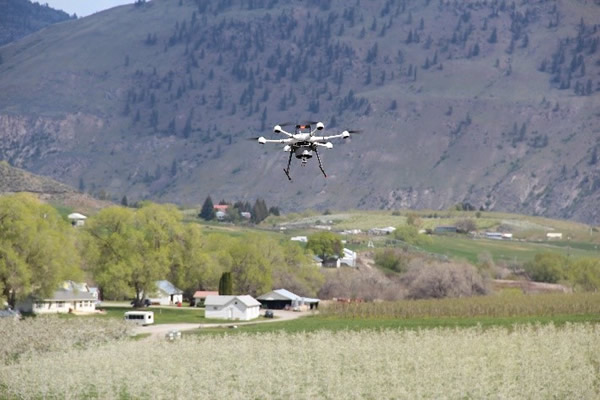
Utilizing drone technology to aid in codling moth control in Washington. Photos by Kacie Athey.
I am excited to be here since Illinois has such a diversity of specialty crops. I love this part of the country; it is nice to be back and I look forward to working with everyone.
Once Dr. Athey’s U of I contact information is complete, we will make it available in the next issue of the newsletter, and at that time you will be able to reach out and give her a proper welcome to Illinois.
Pumpkin Field Day Virtual & In-Person September 3
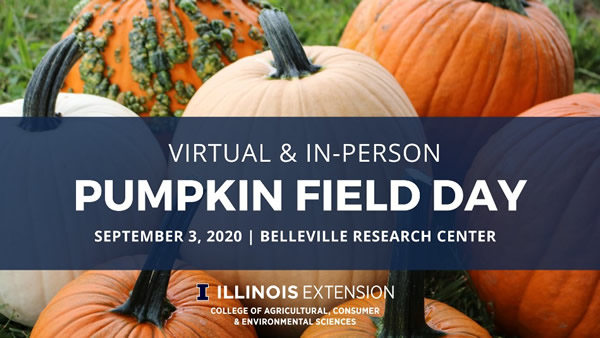
Join University of Illinois Extension at the Belleville Research Center for an update on its 2020 pumpkin field trials for a virtual or in-person tour.
Learn more about commercial pumpkin production including, fertility management, variety selection, no-till production, and insect disease and weed management. This year’s trials include more than 80 pumpkin varieties including gourds, jack-o’-lantern, pie-sized, specialty pumpkins of all shapes and colors, nitrogen management, and weed management trials.
Both tour options are free, but please pre-register.
In-Person Tours
Tours at 10 am, 1 pm or 2 pm | Register Online
Belleville Research Center, 2036 Charles Lane, Belleville, IL 62221
Presenters will introduce the field trials, address various pest and production related topics and further discussion. Participants can then take a self-guided tour of the plots, which will have signs detailing trial information. Light refreshments will be provided.
Tours are limited to 20 participants each. Pre-registration is required. It is highly suggested that participants wear masks. Social distancing practices will be followed.
The program is subject to change subject to local or state health guidelines. Registered participants will be notified via email should any changes be made.
Virtual Tour
Noon CDT | Register Online
Join us from the comfort of your home or office for a live in-field tour of some of the research trial highlights and management and research updates from pumpkin researchers on a wide range of topics related to commercial pumpkin production. Presenters will give a brief update on their areas of expertise before answering questions from participants.
For more information: Please contact the program coordinator Illinois Extension Commercial Agriculture Educator Nathan Johanning at njohann@illinois.edu.
ILFMA COVID-19 Mini-Grant and Technical Assistance Opportunity
ILFMA has been providing guidance for market operations for each phase of the Restore Illinois plan. Now, in partnership with Compeer Financial, ILFMA will provide Mini-Grants to offset COVID-19 operating costs and technical assistance to help get markets open safely and marketing strategies to gain customer confidence and sales.
Grants will be awarded on a rolling basis and applications are requested by August 21, 2020. Apply today as funding is limited
Regional Reports
From the St. Louis Metro east… Last week was rough in terms of rain accumulation, with some in the St Louis metro east having received more than 8” over a fairly short window. I personally received 4.5 inches on August 9 in a 40 minute window, followed by another 3.5 inches over the next few days. Fortunately, the St Louis Metro East did not experience the extreme wind conditions experienced in more northern Illinois and Iowa. The wind put some fruit on the ground but most of the damage came in the form of washed out roads and downed trees in the landscape. Evenings have started to cool into the upper 60’s making for better conditions to color apples and tomatoes. Peach season is ending for those with Cresthaven as their last maturity date, but ongoing for those with late cultivars like Encore, Autumnstar or Laurol to overlap with the beginning of apple season. Main season vegetables are still in harvest, including tomatoes, and sweet corn.
It is with sadness that I report the passing of two leaders within our Illinois specialty grower family. On behalf of University of Illinois Extension, our deepest sympathy goes to their families and friends.
William “Bill” Flamm was among the fourth generation, along with his late brother Leonard “Slim” and late cousin Ed, to spend his life building Flamm Orchards (Cobden) into what it is today. On July 6, Bill died peacefully in his childhood home, surrounded by his family at the age of 83 https://thesouthern.com/news/local/obituaries/
Allen Myers after leaving the Navy, followed in his father’s footsteps to run Myers Orchard (Centralia) from 1956 to 1990, and during that time he served as President of the Illinois State Horticulture Society. Allen Myers, 88, passed away on July 20, at the age of 88. https://www.esterdahl.com/listings
Elizabeth Wahle (618-344-4230; wahle@illinois.edu)
From southwestern Illinois (Waterloo)… We are finally drying out after what felt like endless rain in July and the first half of August. Fortunately, locally near Waterloo we haven’t been hit with the amount of rain that others have had. I think in the last month we have had about 4-5” of rain. Most of it came at a time in a period with almost daily rainfall so crops just continually stayed wet with lots of clouds and high humidity. The Belleville Research Center has not been so lucky. They have had the second wettest July on record, and since July 1 they have received over 19” of rain. Finally, this past week temperatures and humidity have moderated and daily sun abounds. This has been a welcomed change with low rain chances in the forecast, but the heat and humidity returning by the weekend. I am hoping that the two hurricanes predicted to hit the Gulf of Mexico don’t track our way and inundated us with more excessive rain.
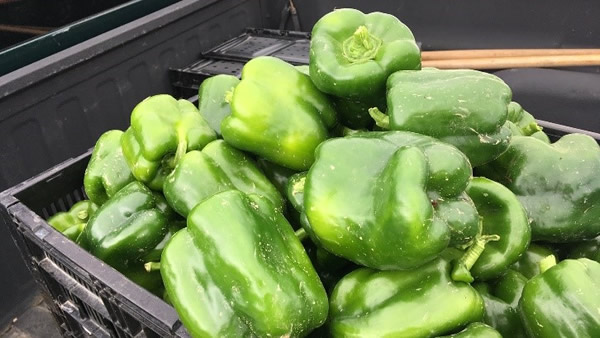
Summer crops are plentiful and local markets are busy! Our trials tillage/cover crop trials at both Urbana and Waterloo are doing well. The Urbana site the tomatoes have struggled with hail and also some persistent crows that feed on the tomatoes, but the peppers look good. All of the rain has made for lots of cracked tomatoes, but I am hopefully with more even moisture the mid-season harvests will be better. The peppers on the other hand are doing great! The variety we used was ‘Karisma’ and from what I have seen I would highly recommend it. The plants are not overly tall (less than 2 ft) but have loaded on the peppers. The quality and size are amazing. The majority of peppers are over ½ lb and have a very nice shape. I haven’t tallied any of the harvest numbers but all of the cover crop and tillage treatments seem to be doing well. Plants in the no-till, cereal rye roll/crimped treatment that had no herbicide (organic weed management) have a little lighter color to foliage. I think nitrogen is in play here with they rye growing and not breaking down as fast, weed uptake (weeds are maintained in the row, but mowed between rows). This effect was more pronounced at Urbana, than Waterloo. This is within the lines of what we see in other nitrogen needy crops behind cereal rye, but the growing season can change how the plants react. All have been fertigated weekly and equally and otherwise look good. We will see in the end what the total yields tell us. This is where, as a researcher, I now have more research questions regarding fertility management and termination timing.
Another observation is fruit cleanliness especially on the peppers. With all for the rain the conventional tillage peppers were just covered in soil. Compare that with the no-till with cereal rye that were almost perfectly clean.


Conventional Tilled bell peppers (left) compared with no-till peppers on cereal rye (right) during a rainy harvest season. Note the difference in soil splash on the fruit. Photos: N. Johanning
Pumpkins are doing well, with the exception of low areas of fields where heavy rains occurred. At home my pumpkins are doing well although got in just a few days later than I wanted with the rains and are still a little behind where I would like them to be. I have small green fruit set but not many that are to mature size. During the rainy period I did notice a lot of aborted fruit some that never even bloomed. My thought is that even though rain wasn’t as excessive the continued moisture may have added some subtle stress. Otherwise the vines have a great color and are healthy. I just started preventative fungicide sprays and will continue every 7-10 days. At Belleville for our pumpkin field day trials we have two fields both about 400 feet apart. One is on a ridge with a little slope and the other is naturally wetter and has decreased drainage. One field looks amazing and the other is struggling to stay alive. This is affecting our gourds and pie pumpkins of the variety trial. Hopefully we will still have a few sample fruits but won’t be able to collect the same amount of yield data we planned on for those varieties. But what do you expect when you have 6 months worth of rain in 1.5 months??
Hope to see some of you in-person and virtually at our Pumpkin Field Day. While different format than in the past we still want to share research and update growers as best we can! As if that is not enough Pumpkin info for your myself and Brad Bergefurd from Ohio will be on the Great Lakes Vegetable Producer’s Network on Wednesday September 2 discussing pumpkins.
Nathan Johanning (618-939-3434; njohann@illinois.edu)
From southern Illinois (Murphysboro)… This month saw the peak in the tomato harvest. As of August 17, the fertigation trial has been harvested six times. The largest harvest on July 27 yielded 420 lbs of marketable tomatoes; followed by the harvest on August 3 that yielded 378 lbs of marketable fruit. Most of the tomatoes harvested were donated to food pantries in Murphysboro and Carbondale. Signs of anthracnose were noticed after the 4th harvest, and an application of Quadris was made. On August 10, five fruit from each plot (total of 15 per treatment) were randomly selected and cut open to check for white cores. Some observational differences between the treatments was noted, but I have yet to fully analyze the yield data.
The heirloom showcasing has been harvested five times and has started to slow in production. The recent heavy rains caused extensive cracking and resulted in some disease issues. Applications of Bravo, alternated with Quintec, and paired with copper have helped.
In the high tunnel, the peppers are still going strong. The rows of cucumbers and tomatoes are being removed to make room for carrots.
Enjoy what is left of summer!
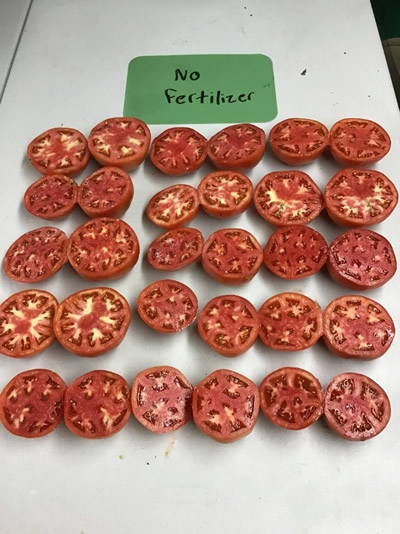
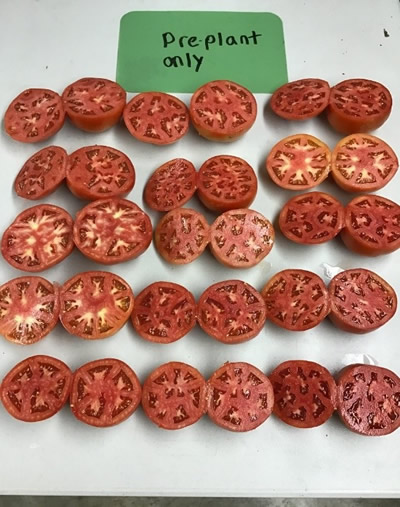

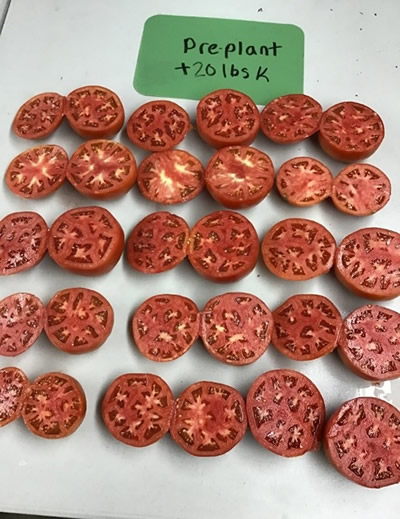
Cross section slices of ‘Red Deuce’ tomatoes representing each of the four treatments included in the tomato fertigation trial at the Jackson Co. Extension office. Fruit was evaluated for occurrence of white core. Photos by K. Bell.
Katie Bell (618-687-1727; klbell@illinois.edu)
From Dixon Springs Ag Center…The last several of days of cooler, dry air has been a welcomed relief over the last month of hot, muggy weather we have been experiencing in far southern Illinois. The main bulk of tomato and bell pepper harvest is basically over for us in the high tunnels this season, with a few green fruit sizing in the top of the plants that will give us a bit to eat on in September. The last few days of cooler temperatures have been appreciated by the hydroponic cucumbers, bell peppers and strawberries, as fruit quality and set has improved compared to three weeks ago.
A small tomato taste test was conducted with a few of the essential workers on site at DSAC the last week of July. The participants were asked to fill out a score sheet on each variety, with a possible score of 1-5 (1 = highly undesireable and 5 = excellent) in each of the following categories: texture, interior appearance, exterior appearance, skin, flavor, and an overall rating. No variety names were made available, just numbers that had been assigned to the varieties beforehand. Thirteen varieties were included in the taste test and the averaged results from all of the participants are as follows:
Average rating based on interior and exterior appearance:
|
Average rating based on texture:
|
Average rating based on flavor:
|
Average rating of the tomato skin:
|
Average overall rating:
|
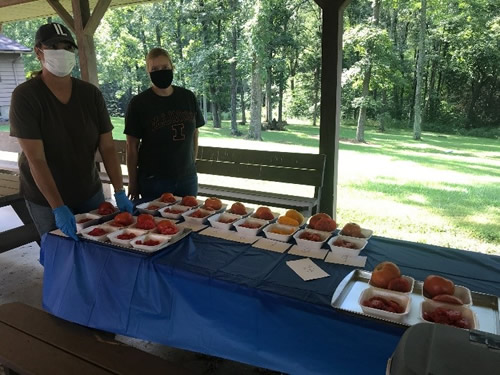 |
Tomato taste testing at DSAC. Photo by B. Aly.
The next couple of pictures show both beneficial and harmful insect pests on cucumbers in the hydroponic tunnel. From armyworm feeding to bumble bee pollination, scouting for insects is important throughout the whole production season.
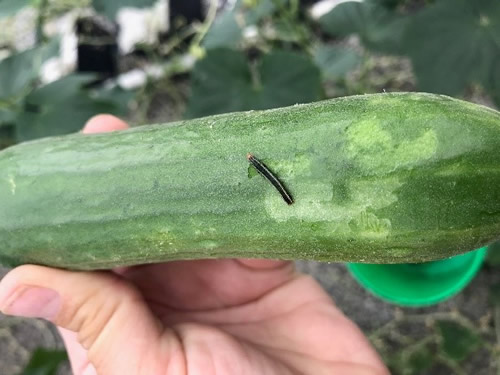
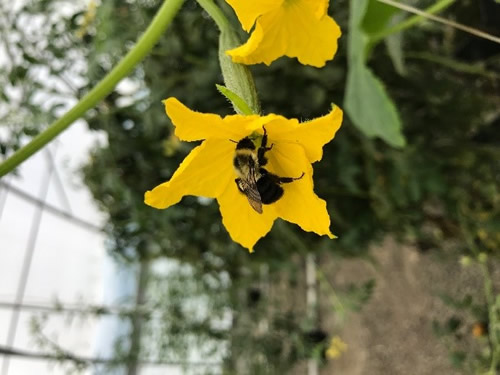
Left to Right: Armyworm larvae caught in the act of creating feeding damage on cucumber fruit and a bumble bee visiting an open cucumber blossom. Photos by B. Aly.
I will continue to put in a plug for our Illinois Extension Local Foods & Small Farms YouTube channel, Illinois LocalFoods Video content is continuing to be added to the channel weekly, with content being organized into playlists based on subject matter or specific vlog locations, including Local Food Happenings at DSAC , The Urban Ag Connect Vlog Series and the Beginning Food Production Resources. The most recent additions include videos discussing nitrogen management and weed management in pumpkins as well as trellising hydroponic raspberries in a high tunnel. Check it out and subscribe today!
Bronwyn Aly (618-382-2662; baly@illinois.edu)
Fruit & Vegetable Production & Pest Management
Cucurbit Downy Mildew Confirmed in Illinois
The following information was shared by Dr. Mohammad Babadoost in an email last week:
On Thursday (August 13th), I was handed two processing pumpkin leaf samples collected from Carmi and Norris cities in White County, Illinois. Microscopic observations showed heavy sporulation of cucurbit downy mildew pathogen on the leaves. With this, I confirm occurrence of cucurbit downy mildew in Illinois in 2020. This strain of the pathogen will likely infect all cucurbit plants. I have not observed downy mildew in other pumpkin growing areas of the state yet. However, Depending on the rainfalls and wind direction, the pathogen can rapidly spread to all cucurbit fields. We have tested and determined efficacy of commercially available fungicides for managing downy mildew of cucurbits in Illinois. I recommend spraying your plants at first sign of the disease in your field or neighboring fields with the following fungicides.
Orondis Ultra (8 fl oz/acre) or Orondis Opti (2.5 pt/acre) alternated with Ranman (2.75 fl oz/acre) at weekly interval.
For additional information, suggested sprays for management of pumpkin diseases in Illinois in 2020 and the related Factsheet is attached.
Regards,
Mohammad Babadoost
Professor of Plant Pathology and Extension Specialist
Department of Crop Sciences
N-533 Turner Hall
1102 S. Goodwin Ave.
Urbana, Illinois 61801
Phone: 217-333-1523
babadoos@illinois.edu
Less Seriously



University of Illinois Extension Specialists in Fruit and Vegetable Production & Pest Management
Extension Educators – Local Food Systems and Small Farms |
||
Bronwyn Aly, Gallatin, Hamilton, Hardin, Pope, Saline, and White counties |
618-382-2662 |
|
Katie Bell, Franklin, Jackson, Perry, Randolph, & Williamson counties |
618-687-1727 |
|
Sarah Farley, Lake & McHenry counties |
847-223-8627 |
|
Nick Frillman, Woodford, Livingston, & McLean counties |
309-663-8306 |
|
Laurie George, Bond, Clinton, Jefferson, Marion, & Washington counties |
618-548-1446 |
|
Zachary Grant, Cook County | 708-679-6889 | |
Doug Gucker, DeWitt, Macon, and Piatt counties |
217-877-6042 |
|
Erin Harper, Champaign, Ford, Iroquois, and Vermillion counties |
217-333-7672 |
|
Grace Margherio, Jackie Joyner-Kersee Center, St. Clair County |
217-244-3547 |
|
Grant McCarty, Jo Daviess, Stephenson, and Winnebago counties |
815-235-4125 |
|
Katie Parker, Adams, Brown, Hancock, Pike and Schuyler counties |
217-223-8380 |
|
Kathryn Pereira, Cook County |
773-233-2900 |
|
James Theuri, Grundy, Kankakee, and Will counties |
815-933-8337 |
|
Extension Educators – Horticulture |
||
Chris Enroth, Henderson, Knox, McDonough, and Warren counties |
309-837-3939 |
|
Richard Hentschel, DuPage, Kane, and Kendall counties |
630-584-6166 |
|
Andrew Holsinger, Christian, Jersey, Macoupin, & Montgomery counties |
217-532-3941 |
|
Extension Educators - Commercial Agriculture |
||
Elizabeth Wahle, Fruit & Vegetable Production |
618-344-4230 |
|
Nathan Johanning, Madison, Monroe & St. Clair counties |
618-939-3434 |
|
Campus-based Extension Specialists |
||
Kacie Athey, Entomology |
217-244-9916 |
|
Mohammad Babadoost, Plant Pathology |
217-333-1523 |
|